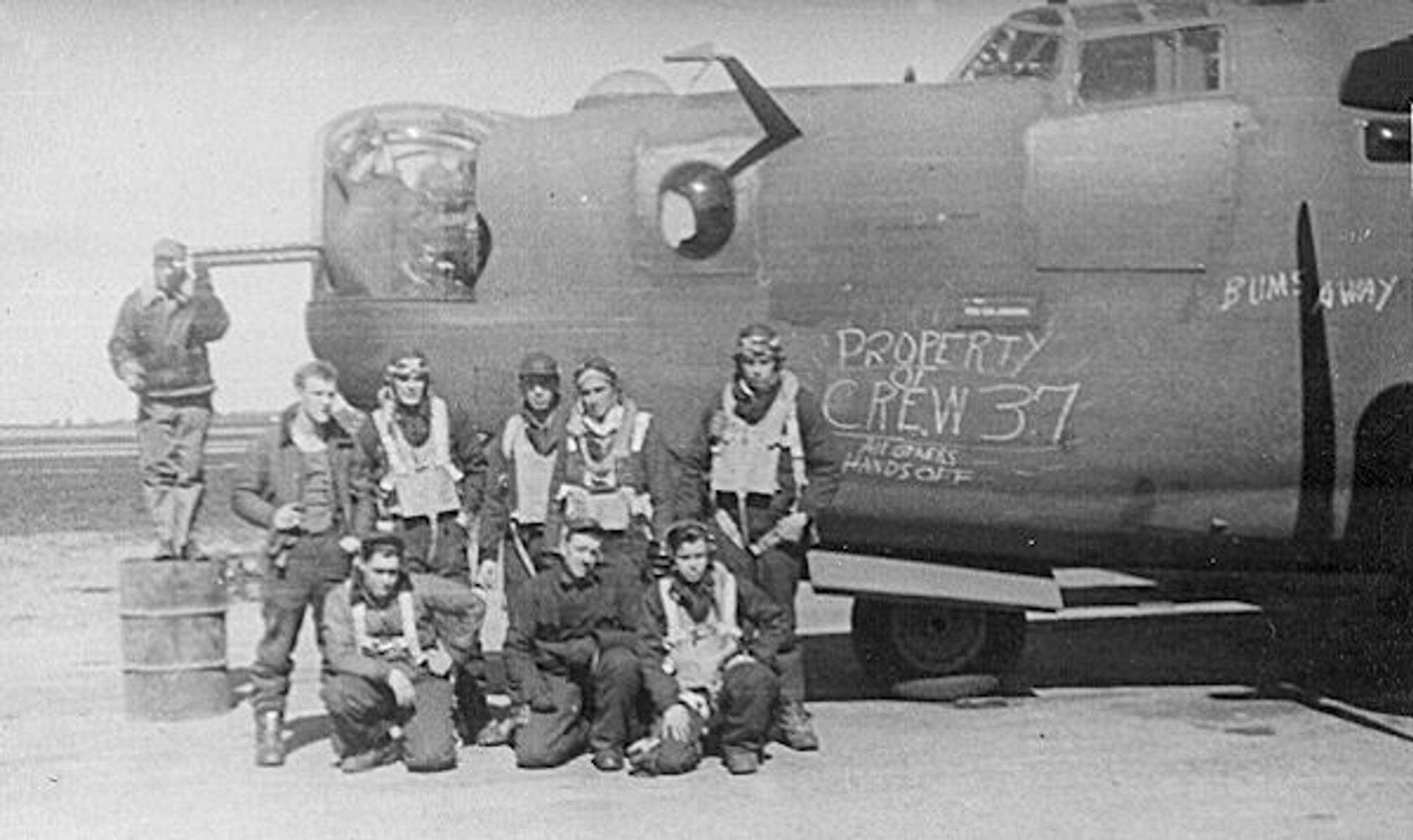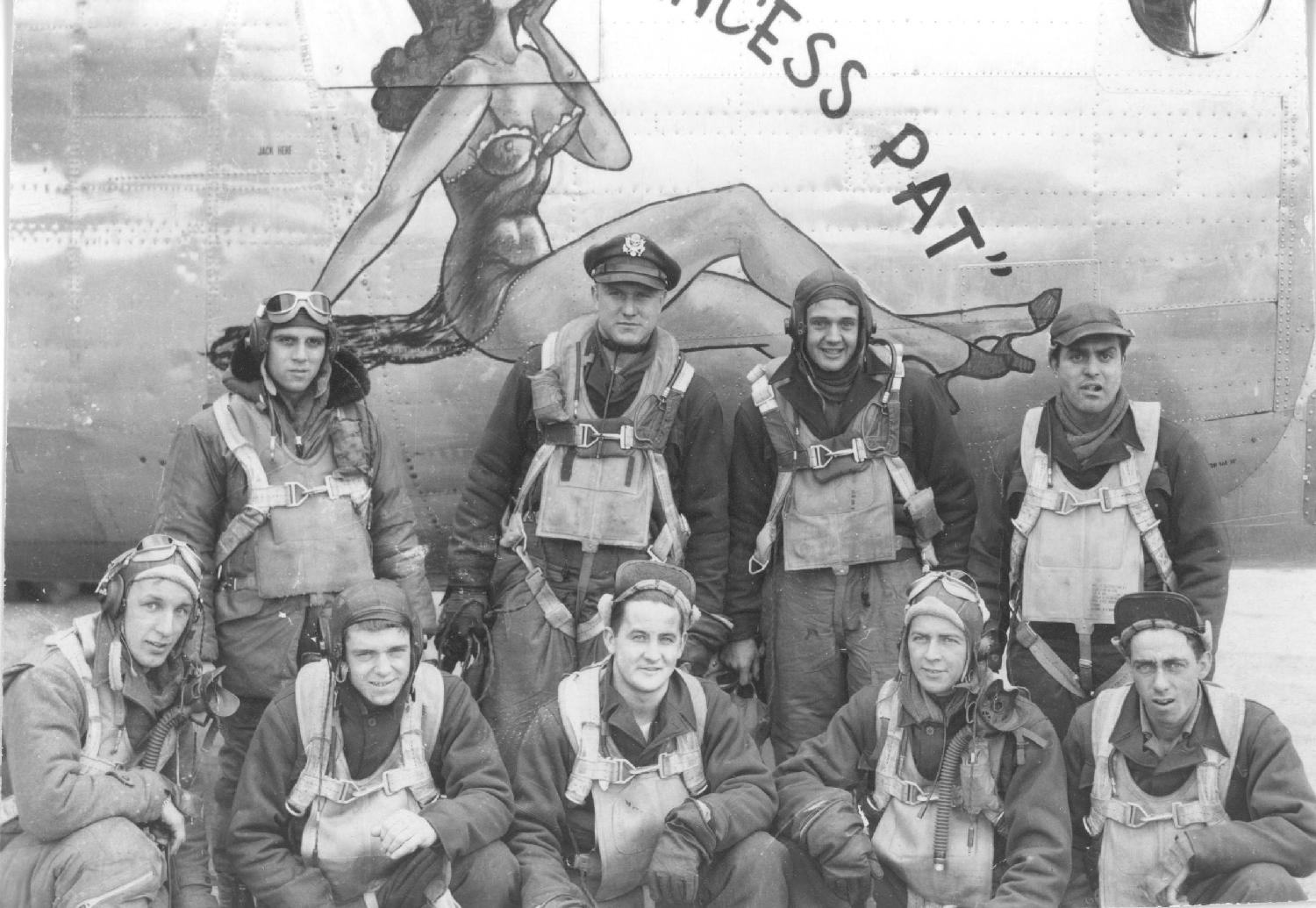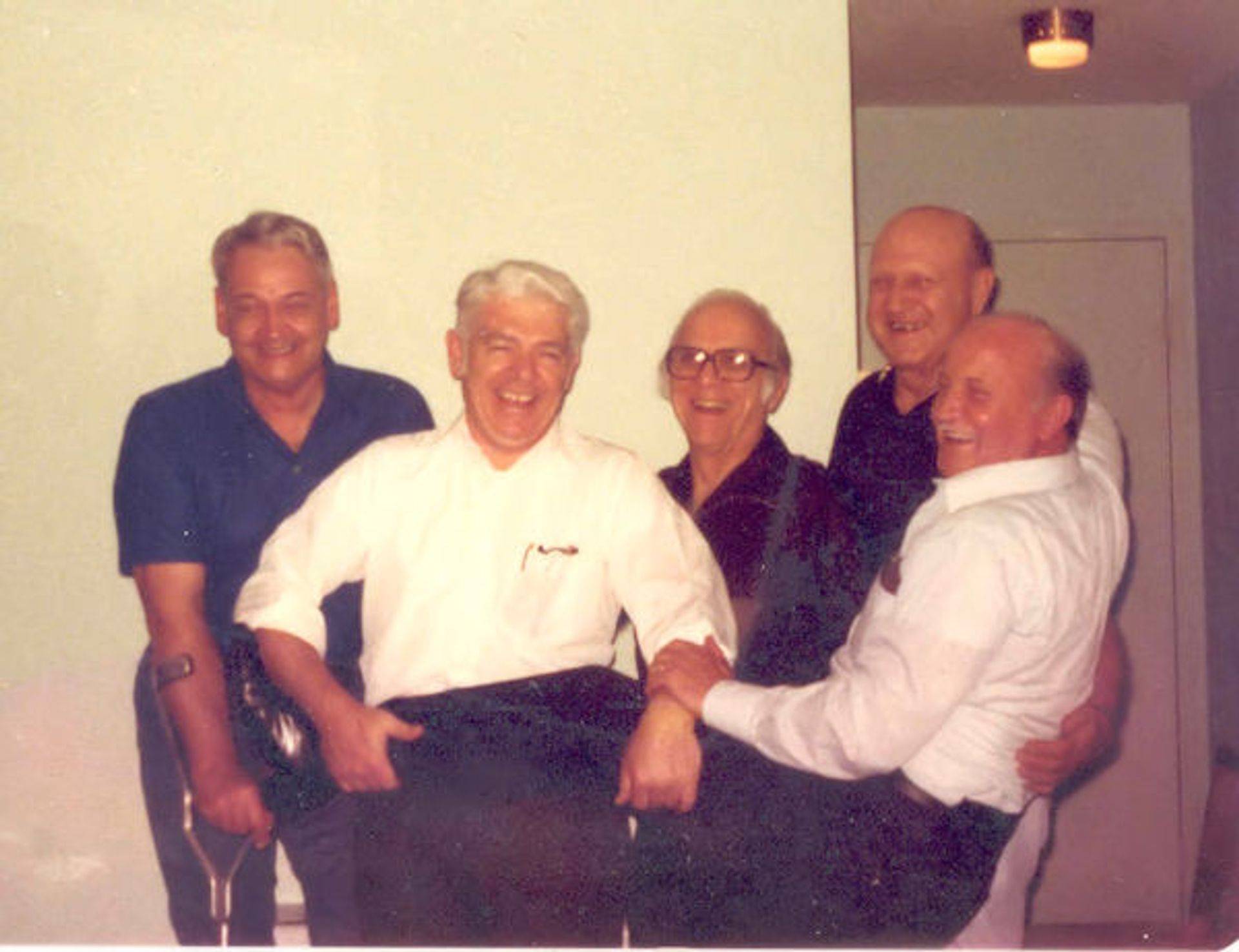458th Bombardment Group (H)
Pilot’s Memoir – 1Lt Curt M. Vogel
Page 3
On our 29th mission [June 4, 1944] we went to Bourges, France. It was an easy mission, with little flak. We took off later in the afternoon and it was getting dark just before landing. Everything appeared normal and when I let down the landing gear I knew the nose wheel dropped and the waist gunner called and said the main gears were down and locked and one of the crew members behind me said the nose wheel was down and locked. We went through this routine on every landing. The green light indicating the wheels were down and locked on the instrument panel also lit up. We were flying an older B-24 on that mission [aircraft is pictured below]. If it had a name I do not remember it. The approach and landing were normal but as I lowered the nose wheel the nose wheel collapsed back into the plane and we were sliding down the runway with the nose of the plane sliding on the runway. We immediately called the tower and came to a stop near the end of the runway. The brakes are on the main landing gear. None of the crew knew of the problem until they heard the noise of the scraping on the runway and none of them even got a bruise. Fortunately the sparks flying around the nose of the plane did not cause any fire. Everybody got out of the plane and the runway was cleared in a matter of minutes but held up the landing of the other planes in the air.

B-24H-20-CF 42-50320 J4 J pictured here with Lt Stephen Davidson crew. Caption reads, “Property of Crew 37. All others – Hands Off“
(Photo: Anne Zimmer)
Debriefing took longer because of the nose wheel collapse. It was probably midnight before we got to bed and about 3 A.M. a sergeant came to my bed and said “Lt. Vogel, wake up, you are flying a mission”. I said something like “I just got to bed” and then asked him what the mission was and he said he didn’t know but we were flying Princess Pat and only 2000 gallons of gas. Princess Pat was a new B-24 we had flown since Rough Riders became disabled, and it flew beautifully. Also, the 2000 gallons meant it was a short mission. Remember this was our 30th mission and completion of our combat tour. When we got to the briefing room, all crew members were there and several of them were obviously upset, as I had been when I was awakened, but when I told them we were flying “Princess Pat” and only 2000 gallons, their reactions changed just like mine did, because we knew we were going on a short mission and in a really good plane.

It turned out to be a very easy mission, because we dropped our bombs on the coast of France and returned to the base. When we landed, the base photographers were there and took our picture with Princess Pat as the background. I have framed this picture and enjoy it except for the fact that Chester Carlstrum was not in it, because he had been killed on his 25th mission flying with another crew.
Nothing was said to me about the nose wheel collapse until about two weeks later. The officer informed me they didn’t find the reason for the collapse of the nose wheel, so they listed it as “pilot error”. Since I had finished my 30 missions, I told him he was wrong but I didn’t care what they called it. (I used a little stronger language.) I still do not know what caused the malfunction but I did find out later that on that series of B-24s the nose wheel was not connected to the green light which indicated the main gear was down and locked.
The green light was on before landing and I know the nose wheel was down but for some reason the lock did not hold after landing. Many times I see “pilot error” listed as cause of an aircraft accident and I wonder if it really is pilot error. One pilot told me he felt the same way about those reports but he added “Vogel, you know as a pilot you get a lot of credit others also deserve, so I guess we should get blamed for some things that are not our fault.
Left: Crew 74 after the June 5, 1944 mission to Stella/Plage, France.
The next day, June 6, 1944, was D-Day, the Normandy invasion. For the Army, Navy and Marines, this was a horrible day measured in casualties, but because of their tremendous valor, dedication and courage, the invasion made it possible to defeat the German war machine. The heavy bombers flew several missions that day, but encountered little or no flak and hardly any enemy fighters. Nelson Stewart, the pilot I went through training with and who was in our squadron, woke me and told me that this was D-Day. All I remember saying was “Good luck” and went back to sleep. June 5, 1944, was our last combat mission, and to me and the crew this day was “Right to live day” or at least our percentage of living went up about 80%.
A few miscellaneous thoughts: I had three leaves while in England, two during my missions and one after I finished the missions. On the first one I went to London with Doyle. We did the usual tourist things including touring St. Paul’s Cathedral, which really impressed me. The second day I went to the Oxford University campus and Doyle did what a 19-year old wants to do. The last two leaves were to Scotland. These were very relaxing and peaceful times. Al Hilborn and West and Walczak also went on one of these trips. We stayed in the Loch Lomond area and also saw Edinborough and Glasgow. The lake area is truly beautiful. We stayed in the town of Drymen, a quiet little town with a very nice small Inn used by many service men on R&R (rest and recuperation leave).
By the above report of some of the missions that I remember the most, you can see that we were not shot down over Europe, the plane was never damaged extensively (except for the engine failure on the 25th mission) by flak damage and enemy fighters, so we were one of the very lucky crews who completed their combat mission. I, and the rest of the crew, did a lot of praying on each mission and I, and the other crew members, in our own way, after the 30th mission, thanked God for his protection. We vowed that we would justify our future existence if we came out of this war alive. When you are placed in positions that require life and death decisions, some decisions made during a normal life take on much less significance than if you never had to make the one that involved life or death.
All members of Crew 74 received the Air Medal after the 5th mission and also three Oak Leaf clusters for other missions. After our 30th mission we received the Distinguished Flying Cross of which we all were very proud. After completing our 30 mission the crew gave me a Model B-24 made of aluminum with a 9″ wing span and the names of the crew members on it. Frankly, this gift means more to me than the medals and I display it proudly in my office. Also, James Stewart, the movie star, was a command pilot of a B-24 Group (not ours). He was flying missions the same time we were flying our missions. I never met him but I understand he was “one of the guys” and everything I heard about him was very complimentary.
British pubs (taverns) around the base were excellent places to relax, although the beer was warm (room temperature) and rather flat compared to lager beer and I enjoyed it. And the “fish and chips” (fried fish and French fries) wrapped in newspapers, bought on the way back to the base, was a pleasant experience. On our missions they always gave us gum and chocolate candy bars, like Mars bars and Snickers. The gum was to help equalize the pressure on the ears when we started our letdown from 20,000 feet or more. Commercial travelers would get these for the same reason until the commercial planes were pressurized. We found out that gum with aluminum wrappers were much more tasty than those wrapped in wax paper, so Joe Brown always tried to get that kind and usually did.

March 23, 1944: The crew’s “Suggestions” for candy bars on their debriefing form.
We got the candy bars shortly before landing and after we took off our oxygen masks. We really looked forward to this snack because we had not eaten for about eight to ten hours and they were frozen (it was always very cold at 20,000 feet). One mission Joe handed me about six pieces of hard sugar candy. I said “You’ve got to be kidding! Let’s have that Snickers bar.” He informed me this was it because it had more energy value than the candy bar according to the guy who gave out the candy. All crew members and crews on the other planes had the same reaction I had. As we entered the debriefing room and sat down, the debriefing officer said “Before we start I want to make it clear -I don’t want to hear a damn thing about that hard candy. You guys go up there and get your butts shot off, and all you can think about is that damn candy.” We didn’t discuss candy, but after that one mission we got our candy bars. I still enjoy a Snicker bar. We also got a shot of bourbon whisky at the debriefing session, if we wanted it. I didn’t particularly like straight whiskey, but did always drink it since it did help me to relax.
Toward the end of July the military flew me back in a B-24 converted cargo plane to Boston and then by train back to Odessa, Missouri. Seeing Jean and Buddy was an unbelievably happy reunion. After about 20 days of leave time we went to Miami, Florida, for about a week. The guys, all combat veterans, went through a lot of tests but for the wives it was a real restful vacation. The army had taken over some of the large seaside hotels so the accommodations were excellent. Next they sent us to Bryan, Texas, as instructors, but after about three weeks, we were to be transferred to Langley Field, Virginia, near Newport News. They were going to fly us to Langley Field, but I got permission to drive the car since Jean and Buddy were with me. We had 48 hours to get there. It took us 12 hours to pack and get two recapped tires, which left us 36 hours to get there. Jean and I alternated in driving but neither Jean nor I could sleep, and Buddy, being about two years old, wasn’t bad, but a typical two-year old. Stopping to go to the bathroom was kept to a minimum, especially by Buddy, by using a milk carton when he wanted to go No.1. No.2 of course necessitated a short stop. Loss of sleep final caught up with me and at a truck stop I took some tablets used by truckers to keep me awake. They really worked to keep me awake, and we got to Langley Field at 11:30 P.M., 30 minutes before ordered to be there. We went into town and finally found an upstairs room. I remember taking off one shoe and didn’t wake up until 11 A.M. We, as pilots, had been told never to use pills to keep awake and after that experience I never took another. When I got to the field to formally check in found out they didn’t even know the pilots from Bryan were even expected, so we had about 48 hours to wait until someone decided what to do with about 20 of us.
Nelson Stewart and Peggy were in this group and we, after some time, rented a nice house near the base. I was assigned as instructor pilot for B-24 crews who were trained for combat but were getting additional training on Radar bombing. Since the pilots were well trained, this turned out to be a relatively easy assignment. In about February 1945 I was called into operations and asked if I would be interested in being assigned to Judge Advocate (legal). I was really surprised at the offer and then they explained they were looking for a pilot with a law degree to write reviews on court-martial cases that involved flying violations. This sounded o.k.to me and when they said I would be stationed in St. Louis, Missouri, near Kings Highway and Lindell, I couldn’t believe it. I accepted immediately and we left for St. Louis in about one week. I finished my service in St. Louis writing court martial reviews with the Eastern Technical Training Command, which was basically an eight-to-five job and in a nice office with some very fine legal officers. We found a nice apartment on Aldine just off of Kings Highway in north St. Louis. I also got to fly a B-25 bomber, converted to a 7-passenger plane, used to ferry legal officers to the bases we covered, which were at Madison, Wisconsin; Lincoln, Nebraska; Urbana, Illinois and Boca Raton, Florida. In the summer of 1945 World War II ended and I was officially discharged October 19, 1945 (my 29th birthday).
Reunion 1981 – Dayton, Ohio

L-R: Allen Hilborn – CP, Bernie Doyle – RO, Sam Scorza – N, Curt Vogel – P, Joe Brown – E
